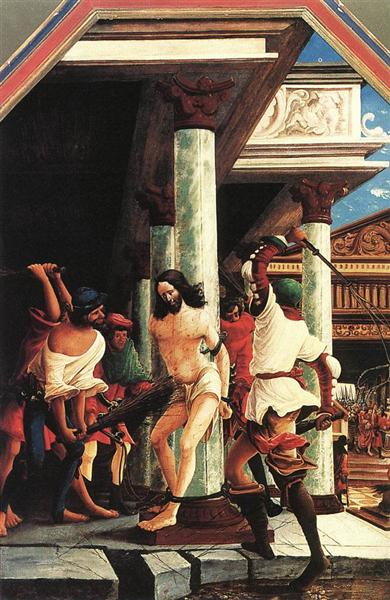Description
The work "The Flagellation of Christ", painted in 1518 by Albrecht Altdorfer, is a fascinating representation that enrolls in the rich tradition of the German rebirth, where the treatment of the religious theme merges with an almost poetic sensitivity and a deep interest in the human experience. Altdorfer, known for its ability to combine visual narrative with an innovative use of color and composition, achieves in this painting to capture the emotional intensity of the moment represented, while inserting a remarkable landscape context that evokes an atmosphere of sublime anguish.
From the compositional point of view, the work is organized intricately but balanced. Christ, at the center of the action, is represented with an agile body, marked by suffering. The way Altdorfer models the torso of Christ highlights the human body in a state of pain, a representation that evidences both the vulnerability and the dignity of the human being in the face of suffering. The figures of the flaglers, who surround Christ in an almost chaotic environment, are presented with a dynamic that reflects the aggressiveness and barbarism of the act itself. These figures, dressed in clothes that contrast with the naked body of Christ, move so that they direct the viewer's attention towards the moment of the flagellation, while simulating a halo of activity and violence.
The use of color in this work is equally remarkable. Altdorfer uses a palette that combines terrible tones and subtle nuances of light, clarifying the effect of pain and suffering that are lived on the scene. The blue and yellow make the figures highlight, while the darkest tones contribute to the creation of a gloomy atmosphere. The color application not only defines the forms, but also establishes an emotional dialogue, where the viewer is involved in the tension of the historical and spiritual experience that develops before his eyes.
The landscape at the top of the work offers a compositional surprise that invites contemplation. Altdorfer, known for its landscapes, introduces a background of trees and mountains that seems to observe the action, a reminder of the duality between the earthly world and a transcendental plane. This inclusion shows the interconnection between human suffering and the greatness of the universe, a distinctive characteristic of the author's artistic approach. The atmosphere of the landscape feels like a melancholic contrast to the horror of flagellation, reinforcing the idea that this suffering occurs in a context that transcends the individual time and space.
The choice of the issue of flagellation is characteristic of the period, where Christ's suffering was addressed as a spiritual nucleus. However, Altdorfer departs from more traditional representations by adding an enormous emotional burden and an almost contemporary vision of sacrilege. This work, together with other similarly intense artists of their time, such as the dramatic elements present in the work of Matthias Grünewald, highlights a deep commitment to the representation of humanity in its most fragile form.
In conclusion, "the flagellation of Christ" of Albrecht Altdorfer is not only an exploration of suffering, but also a testimony of the potential of art to reflect the complexity of human experience. With its intricate composition, its innovative use of color and its ability to challenge the viewer, this work continues to be a powerful invitation to reflection on violence, spirituality and beauty that shines in the midst of suffering. Altdorfer, with his genius, offers us not only a historical moment, but an experience that resonates over time.
KUADROS ©, a famous paint on your wall.
Hand-made oil painting reproductions, with the quality of professional artists and the distinctive seal of KUADROS ©.
Reproduction service paintings With a guarantee of satisfaction. If you are not completely satisfied with the replica of your painting, we refund your money 100%.

